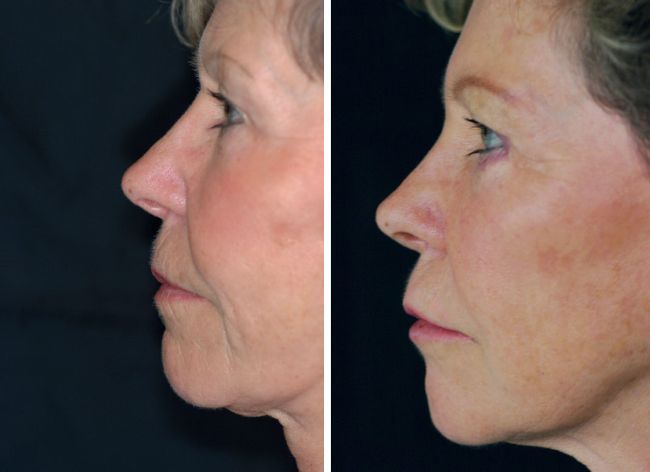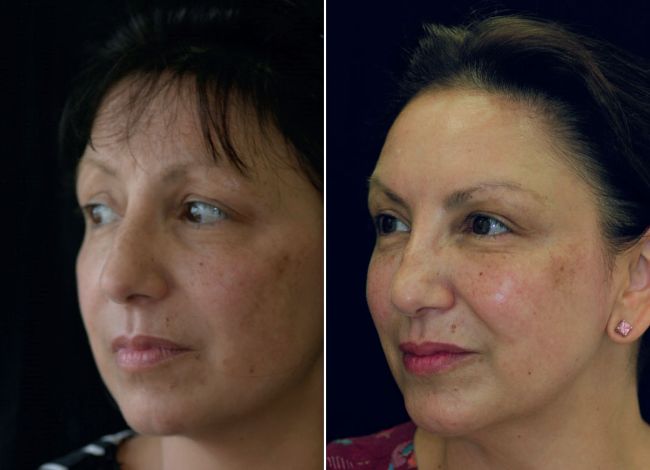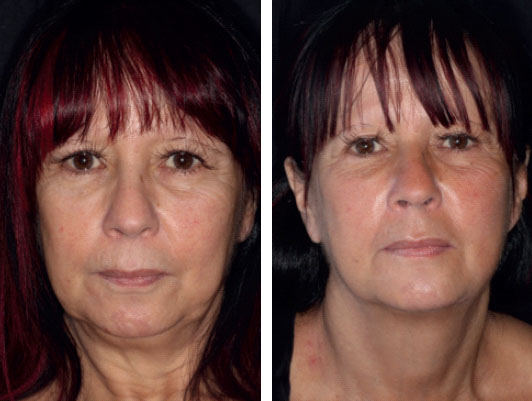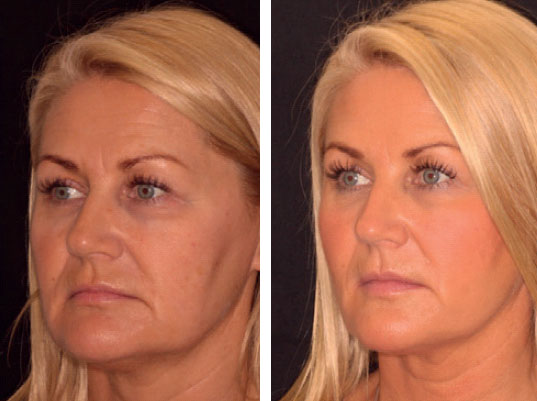A little lift
Dr Ian Hallam MBE explains the importance of skin lifting and tightening in facial rejuvenation and details two of his favoured methods.
DR IAN HALLAM
Dr Ian Hallam MBE qualified in dentistry at Birmingham University in 1971. He is the owner of Meon Dental and Meon Face aesthetic clinic in Petersfield, Hampshire and divides his time between cosmetic and implant dentistry and facial aesthetics. He is an accredited UK trainer for Silhouette Soft, a key opinion leader for Venus Viva and Med Aesthetics and a judge for the Aesthetic Dentistry awards.
In facial aesthetics our aim is to pause or, if possible, reverse the ageing process in order to reserve natural beauty. One of the main factors in the ageing process that leads patients to attend an aesthetic clinic is loss of volume, which leads to an exaggeration of the nasolabial folds, marionette lines and jowls.
However, patients don’t usually ask for “volumisation”; they demonstrate their concern by lifting the skin in an upwards and outwards direction so as to tighten their lower face and jawline and say, “If I could just have this...” What they are really asking for is tightening and lifting.
So, how do we address their concerns? Two of my favoured treatments for lifting and tightening are Silhouette Soft thread lifting and HIFU (high-intensity focused ultrasound).
VOLUMISATION
Volume loss is first noticeable in the anterior cheek region, due to deflation of the medial cheek fat pads. This results in a flattening of the cheeks and the appearance of a naso-jugal groove with an associated exaggeration of the fullness between the naso-jugal groove and the naso-labial fold, which becomes more noticeable as a result. A decade or so ago we used to treat this by injecting a dermal filler into the nasolabial fold. This did not, however, address the cause of the deepening of the fold, which was the loss of volume in the cheek.

Case 1 – Profile view before and after volumisation using fillers and neurotoxin for lifting

Case 2 – Before and after volumisation using fillers and neurotoxin
We now have a better understanding of the ageing process and treat this by injecting a dermal filler with a high G-prime into the anterior cheek at a deep supra-periosteal level to restore the lost volume and, in so doing, it is often not necessary to treat the nasolabial fold, or if so just with a minimal amount of filler. The results are a much more natural restoration of mid-face contour.
In the same way, we can improve the appearance of marionette lines by injecting a dermal filler. However, the cause of the exaggeration of the marrionette lines and the appearance of jowls is soft tissue descent caused by skin laxity, as well as laxity of the retaining ligaments which support the fat compartments, particularly the middle cheek and inferior jowl compartments. This can be improved by injecting a filler along the jawline in the region of the pre-jowl sulcus and into the chin to extend the forward and downwards projection of the chin. It is, however, important to assess the chin from a profile view before deciding if it is appropriate to do this.
But is this enough? It is true that we can achieve a certain amount of lifting and tightening by volumising the mid-face and injecting the jawline with fillers, especially when combined with injecting neurotoxin into the depressor muscles of the neck, the platysma.
However, fillers alone will not fully address the problem, because in addition to volumisation, we also need to tighten and lift the skin.
“The loss of volume is first noticeable in the anterior cheek region, due to deflation of the medial cheek fat pads”
AVAILABLE OPTIONS
There are various ways that we can achieve tightening and lifting, including a surgical facelift, thread lifts, lasers, radiofrequency, ultrasound, plasma treatment using an energy device and PRP (platelet-rich plasma).
In our clinic Meon Face, we use the Venus Viva radiofrequency device, Plasmage, a plasma energy device; PRP, thread lifts and an ultrasound device. The two treatments I consider to give the most effective lifting and skin tightening are Silhouette Soft thread lifting and HIFU using the HIFU MED device by Med Aesthetics.
SILHOUETTE SOFT THREAD LIFTING
Until about a decade ago, the only option to address skin laxity was a surgical facelift, which of course carries greater risk and results in more downtime, as well as being more expensive than non-surgical options. However, with recent developments of fine threads or sutures placed in the subcutaneous layer, we now have an option for addressing skin laxity without surgery. Silhouette Soft sutures are made of polylactic acid, a clear resorbable material and, unlike other sutures such as the PDO (polydioxanone) suture, they incorporate resorbable cones made of L-lactic acid (82%) and glycolic copolymer (18%). These components are particularly compatible with human tissues, are well tolerated and do not require any allergy tests (clinical trial performed on more than 4,000 patients).
Once the suture is applied in the subcutaneous tissue, the polylactic acid stimulates an inflammatory reaction, fibroblast activation and collagen production along the suture. The cones provide an immediate fixation of the overlying skin to give an immediate lifting effect. And the fibrous collagen capsule formed around the cones and along the thread increases the lifting action.
Over a period of time the cones are gradually resorbed in eight to 12 months and the sutures in 18 to 24 months, resulting in a natural lifting effect to restore shapeliness to the face. Silhouette Soft thread lifts can be used to address mid-face skin ptosis, loss of medial cheek fat volume, jawline ptosis (jowls), neck relaxation and brow ptosis.
Thy are not however ideal for all patients, particularly where there is excessive skin in the mandibular region associated with thick skin and with hypertrophic type ageing, excessive skin due to advanced ageing and very thin skin, especially with lack of fat tissue.

Case 3 –Before and 10 weeks post-Silhouette Soft treatment

Case 4 – Before and six weeks post-Silhouette Soft treatment
HIFU
High intensity focused ultrasound (HIFU) works like a magnifying glass to focus sunlight. A transducer focuses the ultrasound waves at the targeted tissues, resulting in heating of those tissues at the focal point only. The superficial tissues (the epidermis and dermis) are not heated.
HIFU is used in aesthetics to increase blood flow in the subcutaneous layer down to the SMAS (superficial musculo-aponeurotic system) to stimulate fibroblasts to create new collagen (neocollagenesis). The targeted tissues are heated to 60-70°C, resulting in denaturation of collagen by breaking the hydrogen bonds. The collagen chains assume a more stable configuration, resulting in shorter, thicker and stronger collagen molecules. This leads to tightening and lifting of the skin.
HIFU is used for:
• Brow lifting
• Jowl lifting
• Mid-face lifting
• Reduction of nasolabial folds
• Reduction of marionette lines
• Neck lifting
• Lifting of the décolletage
• Overall full-body lifting and skin tightening
• Skin rejuvenation
Treatment time with HIFU MED is comparatively short; about an hour for the full face and neck and, compared to other HIFU devices, is quicker and more accurate due to the variability of the lines of shots used in the device head. The treatment is painless and suitable for all skin types and there is no downtime. Optimum results are seen two to three months after treatment and last for over a year. Treatment can be repeated after three to four months and again at a similar interval to continue the process of neocollagenesis, so that the overall results last for up to two years.

HIFU before and after
COMPARISON – SILHOUETTE SOFT AND HIFU MED
The Silhouette Soft thread-lifting technique is a relatively straightforward procedure which gives an immediate natural lifting effect and a progressive restoration of lost collagen. When used in conjunction with other treatment modalities, such as fillers to restore lost volume and contour and radiofrequency or micro-needling for superficial rhytids, thread lifts provide the final treatment option to correct the results of ageing by dealing with skin laxity in a non-surgical way.
However, it is a more invasive procedure than routine filler or neurotoxin injections and requires local anaesthesia. There is also some after-effects and downtime. These include a risk of bruising, tenderness and minor dimpling and puckering of the skin, which may last for up to a week. Patients are advised to avoid exercise, excessive facial expressions and to sleep with their head elevated or face up for one week post treatment.
By comparison, the HIFU MED treatment is non-invasive and painless, requires no local anaesthetic and has absolutely no downtime. After treatment the patient feels a tightening effect, with perhaps a little tingling sensation, but the skin surface is unaffected and the patient can return to work immediately.
As with Silhouette Soft treatment, the optimum results are after two to three months when the collagen stimulation has fully taken effect. A repeat treatment can be carried out three to four months later, followed by a third treatment at a similar interval. The results last for up to two years.
Case selection is very important. Silhouette Soft is not suitable for patients with heavy tissues with thick skin in the mandibular region or very thin aged skin with lack of fat tissue. By comparison HIFU treatment will give a tightening effect on most skin types.
The most effective results can be achieved by a combination of both treatments. Silhouette Soft can be more effective if a HIFU treatment is carried out first because the extra collagen stimulation will result in better anchorage for the sutures. Also, the effects of a Silhouette treatment will be enhanced by a HIFU treatment three to four months afterwards for further collagen stimulation around the sutures.
The final consideration is the cost. Silhouette Soft is a more expensive treatment compared to HIFU MED. Even if the patient has two follow-up HIFU MED treatments over the period of a year, the cost is still lower.
So which treatment is best? Both treatments are very effective and are market-leading, resulting in high patient satisfaction ratings. The correct answer is down to the individual. The facial ageing characteristics of each patient will determine which is the most appropriate treatment or which should be carried out first.
Silhouette Soft results in a more effective lifting effect but HIFU MED results in very effective tightening.
SUMMARY
When a patient attends for a facial consultation, it is important to carry out a thorough assessment so that a harmonious treatment plan, which is tailored to the individual, can be implemented. One of the main signs of ageing is caused by deflation of the supporting fat compartments and, to treat this, it is important to volumise in order to restore a more youthful contour to the face.
Dermal fillers are used to lift, smooth and hydrate the skin to reduce fine lines and wrinkles. But it is also important to lift and tighten and this can be achieved using either thread lifting or HIFU or a combination of both. Combination modalities are the ideal treatment protocol and by introducing a non-invasive energy-based device, such as the HIFU MED, we are able to achieve results which will truly address patient concerns.
REFERENCES
1. Aladin Carovac, Fahrudin Smajlovic, Dzelaludin Junuzovic Application of Ultrasound in Medicine. Acta Informatica Medica, v.19(3):168-171;Sept 2011
2. Levy JA, Noble VE. Bedside ultrasound in pediatric emergency medicine. Pediatrics. 2008 May; 121(5):e 1404-12
3. Raheja R, Brahmavar M, Joshi D, Raman D. Application of Lung Ultrasound in Critical Care Setting: A Review Cureus. 2019 Jul; 11(7): e 5233
4. Janus J, Kanber B, Mahbuba W, Beynon C, Ramnarine KV, Lambert DG, Samani NJ, Stringer EJ, Kelly ME. A preclinical ultrasound method for assessment of vascular disease progression in murine models. Ultrasound: Journal of the British Medical Ultrasound Society. 2018 Aug 7; 27(2): 85-93
5. Hsiao Y et al. Clinical Application of High Intensity Focused Ultrasound in Cancer Therapy. Journal of Cancer. 2016 Vol 7 no 1; 140-146 6. Bass R et al. Oncologic and functional outcome of partial gland ablation with HIFU for localised prostate cancer. Journal of Urology, 2018 S00225347(18)43550-1
7. Marinova M et al. High Intensity focused ultrasound (HIFU) for pancreatic carcinoma: evaluation of feasibility, reduction of tumour volume and pain intensity. European Radiology 2016 vol 26 no 11, 4047-4056
8. Hyunchul P, Eunjin K, Jeongeun K, Youngsuck R, Jooyeon K High Intensity Focused Ultrasound for the Treatment of Wrinkles and Skin Laxity in Seven Different Facial Areas.. Annals of Dermatology. 2015 Dec; 27(6): 688-693
9. Kleinerman R, Whang TB, Bard RL, Marmur ES. Ultrasound in Dermatology: principles and application. J Am Acad Dermatol. 2012;67:478-487
10. Suh DH, Oh YJ, Lee SJ, Rho JH, Song KY, Kim NI, et al. A intense-focused ultrasound tightening for the treatment of infraorbital laxity. Journal of Cosmetic Laser Therapy. 2012;14:290-295
11. Alam M, White LE, Martin N, Witherspoon J, Yoo S, West DP. Ultrasound tightening of facial and neck skin: a raterblinded prospective cohort study. J Am Acad Dermatol. 2010;62:262-269
12. Suh DH, Shin MK, Lee SJ, Rho JH, Lee MH, Kim NI., et al. Intense focused ultrasound tightening in Asian skin: clinical and pathological results. Dermatol Surg. 2011;37:1595-1602
13. Chan NP, Shek SY, Yu CS, Ho SG, Yeung CK, Chan HH. Safety study of transcutaneous focused ultrasound for noninvasive skin tightening in Asians. Lasers Surg Med. 2011;43:366-375
14. Bauer U, Graivier MH. Optimizing injectable poly-L-lactic acid administration for soft tissue augmentation: The rationale for three treatment sessions. Canadian Journal of Plastic Surgery 2011 Fall;19(3):e22-7
15. Schierle CF, Casas LA. Non-surgical rejuvenation of the aging face with injectable poly-L-lactic acid for restoration of soft tissue volume. Aesthetic Surgery Journal, 2011 Jan
16. Lowe P, Lowe NJ, Patnaik R. Three-dimensional digital surface imaging measurement of the volumizing effect of injectable poly-L-lactic acid for naso-labial folds. Journal of Cosmetic and Laser Therapy, 2011 April
17. Tang, Songjia, Sun, Zhongxin, Wu, Xiaoxin, Wang, Yu-Yan, Zhang, Jufang. An innovative thread-lift technique for facial rejuvenation and complication management. A case report. Medicine: 2018 May; v. 97(21): p.e10547
18. Rima A, DeFatta RJ, Williams EF. Thread-lift for Facial Rejuvenation. Assessment of Long-term Results. Arch Facial Plastic Surgery. 2009;11(3):178-183
19. Talakoub L, Wesley N O. Thread lifts: A face-lift alternative? Or not? Dermatology News. 2017 Dec.